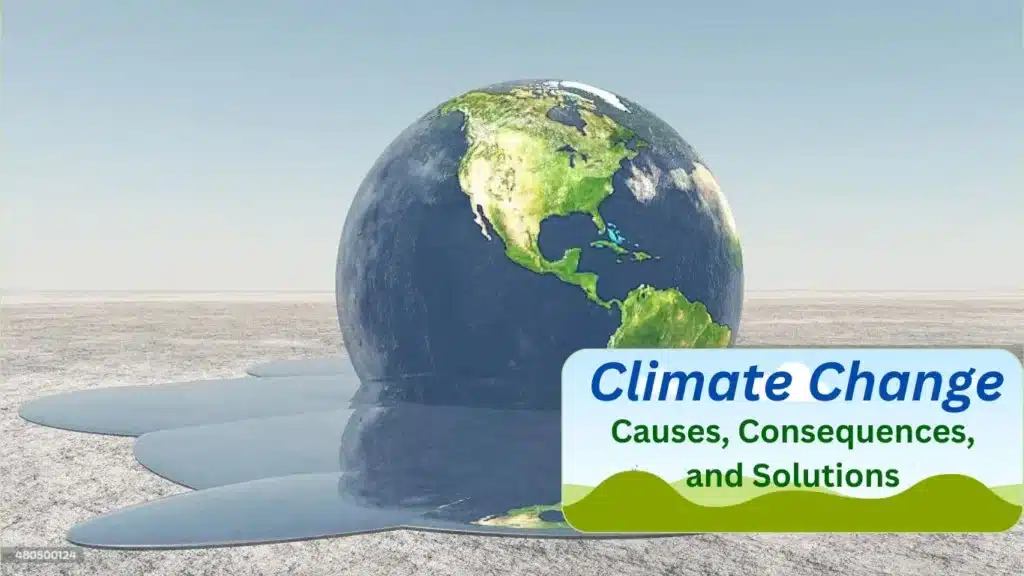Climate Change: Causes, Consequences, and Solutions in the 21st Century!
Last updates: 12:52:33 AM, 04/11/2025
Introduction
Climate change is a crucial global issue that has grabbed the interest of scientists, policymakers, and concerned citizens all around the world. It is a phenomenon with far-reaching consequences for the ecology, economy, and overall quality of life. We are going to look into the complexities of climate change in this comprehensive document, studying its sources, impacts, and potential solutions. We’ll also discuss how these changes might be seen in our everyday lives.

What is climate change?
Climate change refers to long-term alterations in the average weather patterns on Earth. While natural processes have influenced our climate throughout Earth’s history, the term “climate change” is now primarily associated with anthropogenic, or human-induced, changes. These changes are largely driven by the increase in greenhouse gases in the atmosphere, primarily carbon dioxide (CO2), methane (CH4), and nitrous oxide (N2O).
Causes of Climate Change
-
Greenhouse Gas Emissions
The excessive release of greenhouse gases into the atmosphere is the principal cause of modern climate change. Human actions, such as the use of fossil fuels (coal, oil, and natural gas), deforestation, and industrial processes, are mostly to blame.
-
Deforestation
Trees and forests absorb CO₂ from the atmosphere and act as carbon sinks. Deforestation not only releases previously stored carbon, but it also lowers the Earth’s ability to absorb future emissions.
-
Agriculture
Agriculture emits methane and nitrous oxide, two strong greenhouse gases, as a result of agricultural practices such as animal rearing and the use of synthetic fertilizers.
-
Waste Management
Landfills and waste management facilities produce methane emissions as organic waste decomposes.
-
Industrial Processes
Certain industrial activities release greenhouse gases as byproducts, contributing to climate change.
Effects of Climate Change
-
Rising Temperatures
As global temperatures rise, heatwaves become more common and severe. This has the potential to have disastrous implications for human health, agriculture, and ecosystems. Many individuals are experiencing hotter summers and milder winters, which has led to increasing use of air conditioning and changes in clothing choices.
-
Seasonal Changes
Seasonal shifts in time and duration are noted, such as early spring and later autumn. This can have an impact on agriculture, wildlife migration, and outdoor hobbies such as gardening. Farmers are modifying their planting and harvesting dates to accommodate changing weather patterns. They may, for example, plant crops earlier or choose drought-resistant varieties.
-
More Frequent and Severe Heat Waves
Heat waves are becoming more frequent and powerful, causing discomfort, heat-related illnesses, and an increase in demand for cooling systems.
-
Changes in Precipitation Patterns
Precipitation patterns are changing, with some places having more extreme rainfall episodes and others experiencing longer droughts. This can have an impact on agricultural water availability, drinking water supply, and ecosystem health.
-
Melting Glaciers and Ice Sheets
Photographs and news reports show the retreat of glaciers and ice sheets in arctic and mountainous locations. This adds to rising sea levels, which cause coastal erosion and greater tides, which have an impact on coastal populations.
-
Extreme Weather Events
Climate change has been related to an increase in the frequency and intensity of extreme weather events such as hurricanes, floods, droughts, and wildfires. These occurrences cause major damage and loss of life, interfering with daily life and safety.
-
Ocean Acidification
Increased CO2 levels in the atmosphere are absorbed by the seas, causing acidification. This can be dangerous to marine life, especially creatures with calcium carbonate shells or skeletons, such as corals and shellfish.
-
Biodiversity Loss
Climate change disrupts ecosystems, leading to the extinction of many species that cannot adapt to rapid changes in temperature and habitat. Observations include shifts in wildlife populations and plant species ranges.
-
Health Impacts
Climate change exacerbates health issues, including heat-related illnesses, respiratory problems due to air pollution, and the spread of vector-borne diseases. Climate change can influence the spread of infectious diseases, allergens, and air quality, impacting public health. Heat-related illnesses become more common during extreme heat events.
-
Disruption of Traditional Practices
Traditional livelihoods and practices, such as farming, fishing, and indigenous cultural activities, are being disturbed in some regions due to changing climate conditions.
-
Economic Consequences
Each year, climate-related disasters cause billions of dollars in economic damage by disrupting industry, infrastructure, and livelihoods.
Solutions to Climate Change
-
Transition to Renewable Energy
Using renewable energy sources such as solar, wind, and hydroelectric power instead of fossil fuels can considerably cut greenhouse gas emissions. This transformation aids in the fight against rising temperatures and the effects of intense heat waves.
-
Energy Efficiency
Improving energy efficiency in buildings, transportation, and industry reduces overall energy consumption and emissions. It helps to mitigate climate change and adapt to shifting weather patterns.
-
Afforestation and Reforestation
Planting trees and restoring forests can absorb carbon dioxide and counteract the consequences of deforestation, helping to maintain temperatures and seasons.
-
Sustainable Agriculture
Implementing sustainable farming techniques can minimize methane emissions and increase carbon sequestration, assuring food security despite shifting precipitation patterns.
-
Waste Reduction
Reducing, reusing, and recycling waste can assist in reducing waste generation and landfill methane emissions, which can help manage the effects of changing weather patterns.
-
Climate-Friendly Policies
Governments can establish policies and regulations that support renewable energy, carbon pricing, and emissions reduction targets, all of which are critical for tackling climate change and its daily implications.
-
Individual Actions
Everyone may help counteract climate change’s effects on health and well-being by conserving energy, lowering water use, and adopting eco-friendly behaviors in their daily life.
Conclusion
Climate change is a pressing global concern with visible consequences in our daily lives. Understanding its causes, impacts, and potential remedies is critical for people, communities, and nations to work together to address this issue. We can strive towards a more sustainable and resilient future for our planet by taking proactive steps to cut greenhouse gas emissions, migrate to sustainable practices, and support climate-friendly policies. It is our job to act today to protect the environment and future generations’ well-being.
